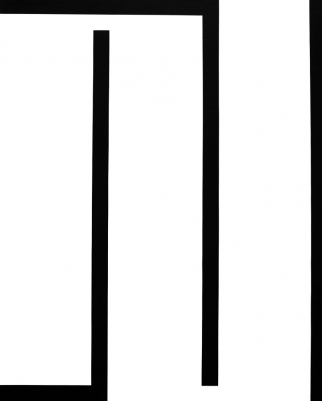Julije Knifer
born in 1924 in Osijek, Croatia
departed in 2004 in Paris, France
"In 1959 I was obsessed with the idea of creating anti-painting. By a certain method of reducing forms and colours I achieved extreme forms of simplicity. The form of the painting was built in extremely contrasting colours - white and black..... The initial stage of my work on canvas consisted of covering the canvas in white. This was already a spiritual part, or spiritual conception of painting.... By adding black, white assumed form, or served for black to assume its form. And colours served solely to form the shape of the painting". (Julije Knifer)
In 1960 the first meander-painting was created by Julije Knifer and with it he discovers the ideal form of expression for his ‘anti-painting’. By using monotone rhythms and the intense contrasts of black and white, he resisted the criteria of the modernity. Knifer used this consciously chosen formal expression stoically from 1960 until his death in 2004. He himself defined it as ‘non-development’: ‘non-development’ as the concept for the elimination of any kind of development under the principal of the repetition of an almost identical motif.
As so many other artists from the former socialistic states of today’s Middle and Eastern Europe, Julije Knifer’s oeuvre has been neglected by art history. References to diverse art historical movements such as to the geometric abstraction or the neo-constructivism of the 1960s, to the anti-art of the neo-avant-garde group ‘Gorgona’, as well as later to minimalism and conceptualism can be found. At the same time his oeuvre can be placed in the same context as the work of On Kawara or Hanne Darboven, who are also interested in the themes of relationship and repetition.
As so many other artists from the former socialistic states of today’s Middle and Eastern Europe, Julije Knifer’s oeuvre has been neglected by art history. References to diverse art historical movements such as to the geometric abstraction or the neo-constructivism of the 1960s, to the anti-art of the neo-avant-garde group ‘Gorgona’, as well as later to minimalism and conceptualism can be found. At the same time his oeuvre can be placed in the same context as the work of On Kawara or Hanne Darboven, who are also interested in the themes of relationship and repetition.
Julije Knifer studied painting at the academy of art in Zagreb. After his studies he became a founding member of the artist group ‘Gorgona’, which was an important segment of the contemporary Croatian art scene in Zagreb from 1959 to 1966. From 1961 to 1973 he participated in the exhibitions ‘The New Tendencies’ at the Museum for Contemporary Art in Zagreb and became part of the movement with the same name, which reached an important platform there. In 2001 he represented Croatia in the 49th edition of the Venice Biennial and was represented in numerous retrospectives of the ‘New Tendencies’ and exhibitions about their influences, e.g. ‘bit international. [Nove] tendencije’ at the ZKM, Karlsruhe 2009. Lately the Grazer Kunstverein dedicated an exhibition to the artist book project Gorgona 1-11 in summer 2010. This so called ‘anti-magazine’ was part of the artistic practise of the participating artists, which next to Julije Knifer also included Josip Vaništa, Ivan Kožaric, Marijan Jevšovar, Mangelos and Miljenko Horvat.
EXHIBITIONS:
10.12. 2010 - 12.02.2011
Julije Knifer
Solo exhibition at ARNDT, Berlin
 Julije Knifer, IX / VIII - II TU HDA, 1987, acrylic on canvas, 200 x 165 cm | 78.74 x 64.96 in, # KNIF0005
Julije Knifer, IX / VIII - II TU HDA, 1987, acrylic on canvas, 200 x 165 cm | 78.74 x 64.96 in, # KNIF0005
Exhibitions
10.12.2010 - 12.02.2011
JULIJE KNIFER
Solo exhibition at ARNDT, Berlin
For press release, please clickhere.
ARNDT is pleased to announce the opening of the first solo exhibition of the Croatian artist JULIJE KNIFER in Berlin on 9 December 2010. The show will be on view from 10 December 2010 until 12 February 2011.
In 1960 the first meander-painting was created by Julije Knifer and with it he discovers the ideal form of expression for his ‘anti-painting’. By using monotone rhythms and the intense contrasts of black and white, he resisted the criteria of the modernity. Knifer used this consciously chosen formal expression stoically from 1960 until his death in 2004. He himself defined it as ‘non-development’: ‘non-development’ as the concept for the elimination of any kind of development under the principal of the repetition of an almost identical motif.
